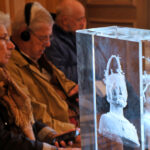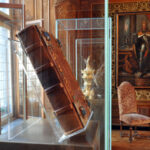Station Power
Rathaus
Aachen’s Town Hall has stood on the foundations of Charlemagne’s King’s Hall since 1349. It was built as an expression of the aspirations of the medieval town and also served as the celebration hall for the coronation banquets of the German kings, which had previously taken place in the King’s Hall.
As a station on the Route Charlemagne, it documents the history of the city and deals with the theme “Power”.
Town Hall: War, peace and Europe
The Town Hall was the first station on the Route Charlemagne to be completed, and was opened to the public in June 2009. All of the historically significant rooms in the Town Hall are now accessible, with the exception of the Granus Tower and the offices of the Lord Mayor.
The Palace of Charlemagne in 3D
The tour begins with a computer simulation of Charlemagne’s palace. It shows which part of the palace complex later became the Town Hall. The Council Hall and the other chambers on the ground floor give an impression of the original Gothic construction and the decor of the 17th and 18th centuries. Some of the paintings show the stylistic transformation of Charlemagne into a timeless icon of sovereignity.
Audio installation, an interactive photo album and an interactive table
In one of these chambers, the “Master Craftsmen’s Kitchen”, photos and film footage recall the Second World War, which came to an earlier end in Aachen than in other German cities. An audio installation in the middle of the room gives an impression of the crimes and atrocities committed by the National Socialists. An interactive photo album illustrates the history of the Town Hall building and its reconstruction.
“Peace” is the theme of the adjacent room, the Red Hall, also known as the Peace Hall. It was specially decorated and furnished in 1748 for the ceremonial signing of a peace treaty which was to end the Austrian War of Succession.
Soundscape of a coronation banquet in 1520
The staircase leading up to the Coronation Hall is dedicated to the International Charlemagne Prize. Its history and the speeches of its laureates reflect the concepts and guiding principles of European integration. Visitors can explore the history of this award at interactive computer columns. The most famous room in the Town Hall is the Coronation Hall. In the Middle Ages and in early modern times, this was the venue for the magnificent coronation banquets of the kings who had just been crowned on the same day in St. Mary’s Church. The coronation Hall also houses replicas of the medieval imperial crown and the other imperial regalia. The walls are adorned with Alfred Rethel’s cycle of frescoes depicting scenes from the life of Charlemagne, including Rethel’s undisputed masterpiece, “Battle of Cordoba” from 1849/50. The frescoes give an impression of how the 19th century viewed Charlemagne.


















